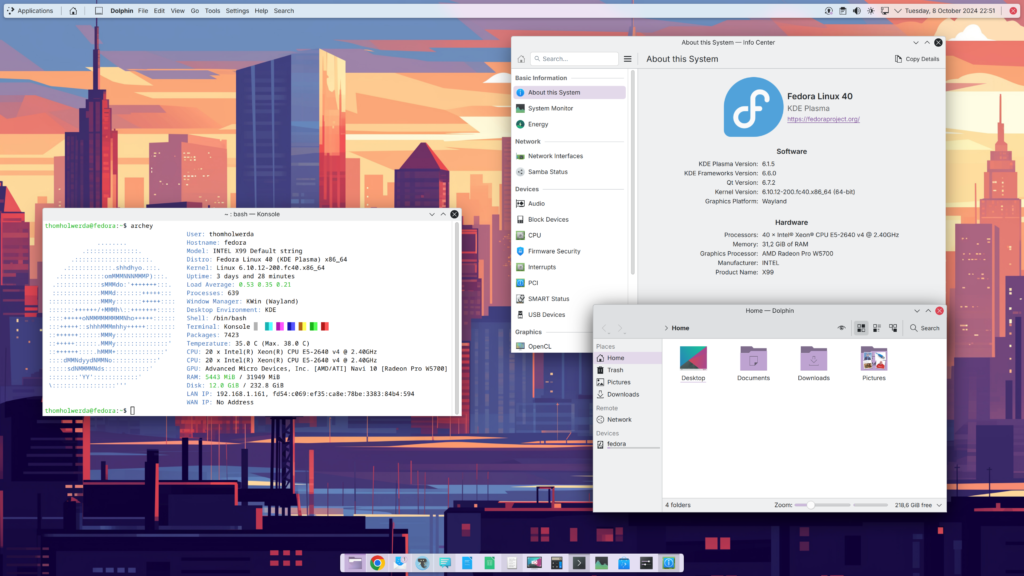Over the decades, my primary operating system of choice has changed a few times. As a wee child of six years old, we got out first PC through one of those employer buy-a-PC programs, where an employer would subsidize its employees buying PCs for use in the home. The goal here was simple: if people get comfortable with a computer in their private life, they’ll also get comfortable with it in their professional life. And so, through my mother’s employer, we got a brand new 286 desktop running MS-DOS and Windows 3.0. I still have the massive and detailed manuals and original installation floppies it came with. So, my first operating system of ‘choice’ was MS-DOS, and to a far lesser extent Windows 3.0. As my childhood progressed, we got progressively better computers, and the new Windows versions that came with it – Windows 95, 98, and yes, even ME, which I remarkably liked just fine. Starting with Windows 95, DOS became an afterthought, and with my schools, too, being entirely Windows-only, my teenage years were all Windows, all the time. So, when I bought my first own, brand new computer – instead of old 386 machines my parents took home from work – right around when Windows XP came out, I bought a totally legal copy of Windows XP from some dude at school that somehow came on a CD-R with a handwritten label but was really totally legit you guys. I didn’t like Windows XP at all, and immediately started looking for alternatives, trying out Mandrake Linux before discovering something called BeOS – and despite BeOS already being over by that point, I had found my operating system of choice. I tried to make it last as long as the BeOS community would let me, but that wasn’t very long. The next step was a move to the Mac, something that was quite rare in The Netherlands at that time. During that same time, Microsoft released Windows Server 2003, the actually good version of Windows XP, and a vibrant community of people, including myself, started using it as a desktop operating system instead. I continued using this mix of Mac OS X and Windows – even Vista – for a long time, while having various iterations of Linux installed on the side. I eventually lost interest in Mac OS X because Apple lost interest in it (I think around the Snow Leopard era?), and years later, six or seven years ago or so, I moved to Linux exclusively, fully ditching Windows even for gaming like four or so years ago when Valve’s Proton started picking up steam. Nowadays all my machines run Fedora KDE, which I consider to be by far the best desktop operating system experience you can get today. Over the last few years or so, I’ve noticed something fun and interesting in how I set up my machines: you can find hints of my operating system history all over my preferred setup and settings. I picked up all kinds of usage patterns and expectations from all those different operating systems, and I’d like to enable as many of those as possible in my computing environment. In a way, my setup is a reflection of the operating systems I used in the past, an archaeological record of my computing history, an evolutionary tree of good traits that survived, and bad traits bred out. Taking a look at my bare desktop, you’ll instantly pick up on the fact I used to use Mac OS X for a long time. The Mac OS X-like dock at the bottom of the screen has been my preferred way of opening and managing running applications since I first got an iBook G4 more than 20 years ago, and to this day I find it far superior to any alternatives. KDE lets me easily recreate a proper dock, without having to resort to any third-party dock applications. I never liked the magnification trick Mac OS X wowed audiences with when it was new, so I don’t use it. The next dead giveaway I used to be a Mac OS X user a long time ago is the top bar, which shares quite a few elements with the Mac OS X menubar, while also containing elements not found in Mac OS X. I keep the KDE equivalent of a start menu there, a button that brings up my home folder in a KDE folder view, a show desktop button that’s mostly there for aesthetic reasons, KDE’s global menubar widget for that Mac OS X feel, a system tray, the clock, and then a close button that opens up a custom system menu with shutdown/reboot/etc. commands and some shortcuts to system tools. Another feature coming straight from my days using Mac OS X is KDE’s equivalent of Exposé, called Overview, without which I wouldn’t know how to find a window if my life depended on it. I bind it to the top-left hotcorner for easy access with my mouse, while the bottom-right hotcorner is set to show my desktop (and the reason why I technically don’t really need that show desktop button I mentioned earlier). I fiddled with the hot corner trigger timings so that they fire virtually instantly. Waiting on my computer is so ’90s. It’s not really possible to see in screenshots, but my stint using BeOS as my main operating system back when that was a thing you could do also shines through, specifically in the way I manage windows. In BeOS, double-clicking a titlebar tab would minimise a window, and right-clicking the tab would send the window to the bottom of the Z-stack. I haven’t maximised a non-video window in several decades, so I find double-clicking a titlebar to maximise a window utterly baffling, and a ridiculous Windows-ism I want nothing to do with. Once again, KDE lets me set this up exactly the way I want, and I genuinely feel lost when I can’t manipulate my windows in this




